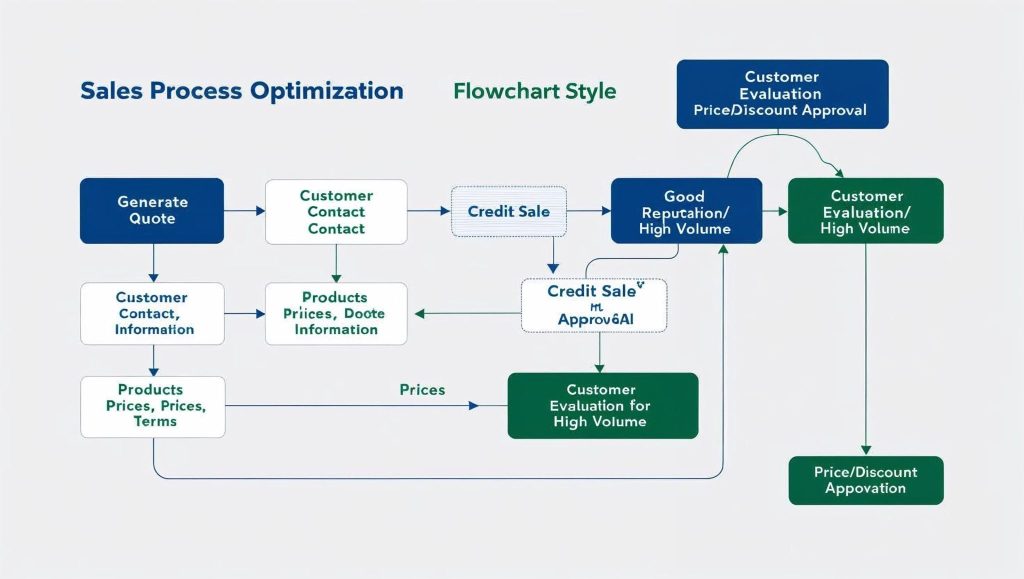Every organization has a process or area it wants to optimize—whether it’s commercial, operational, or logistical—and chooses custom software development services. Discover how we do it.
Step 1: Process Optimization Service
To optimize processes, it is essential to understand the organization’s business and define each of the processes involved in generating value for the product or service.
Let’s define a basic scenario to dive into the topic. An automotive parts importing company sells these products to mechanical workshops nationwide. We can identify the following (basic and summarized) processes:
Procurement Process: Coordination with the overseas supplier, purchase order issuance, importation, customs clearance, and warehouse registration.
Marketing Process: Notification to various workshops about imported products, including new and second-hand items, special offers, distribution of information through brochures or the website, and phone calls.
Sales Process: Coordination with workshops to receive their spare parts orders, send quotations with authorized discounts.
Logistics Process: Shipment of spare parts and receipt of warranty-covered parts.
Support and Warranty Process: Inspection of warranty-covered spare parts, submission of RMA to the overseas supplier, returns, and replacement of parts, etc.
Once we have defined the processes, we proceed to design and model the information flow to determine which documents or relevant information each process generates.
For example, the sales process generates quotations, which include all customer contact and billing information, the listed products, prices, and sales terms. If the sale is on credit, the customer undergoes an evaluation process.
Similarly, the sales process requires lowering prices for customers with a strong reputation in terms of purchase volume and payment promptness, making it necessary to evaluate the customer as well.

Here we can identify that customer evaluation is used to apply prices and discounts as well as to approve credit. Performing customer evaluation for each activity is redundant and costly, and this can be optimized with software.
If we isolate only the customer evaluation process (just for the example), we could recommend that, through a screen in a custom-developed system or software, the customer’s code is entered, and it displays their current price list, whether they qualify for credit, and the approved credit amount ranges.
We have illustrated this with a simple and quick exercise to keep the reading engaging. Now, apply this approach to every document and activity across all processes in this organization, and without a doubt, many activities could be digitized, automated, eliminated, or improved.
Step 2: Custom Software Development Service
Once we have defined and documented the process, we proceed to create sketches of potential prototypes, allowing the client to contribute and decide how their application would function.
Custom software development is called “custom” because it builds the exact digital tool you want or need. To achieve this, it must progress from a sketch to a real, functional application.
Once the developed application is available for users, observations, improvements, corrections, and other changes begin to emerge.
It is simply necessary because once the process is optimized by the application, continuous improvement does not stop due to the natural growth of the company. Custom software enables businesses to improve and grow, and as a result, their needs expand, making it a cyclical process.
Due to this need, support is vital.
Continuous Improvement and Support for Custom Software Development
It is common that after completing a custom software development project resulting from process optimization, the client requires support to address any needs that arise while using the application. This support, depending on the complexity, scale of the software, and number of processes involved, can be provided in the following ways:
As a support and programming hour package: If you need “X” hours per month, these hours can be used for programming and development if not all support hours have been utilized.
Additional Support Hours: If a fixed number of support hours per month is not needed, variable monthly hours can be used for both support and programming.
Everything will depend on the maturity of the custom software usage. Many start with a monthly hour package, then move on to using only additional hours, and eventually, the client feels capable of supporting the software through their own IT team, if they have one.
Recommendations
Simply put, whenever you develop custom software for your organization, it is essential to first go through process optimization. This crucial step will ensure a suitable solution for your business with successful results.



